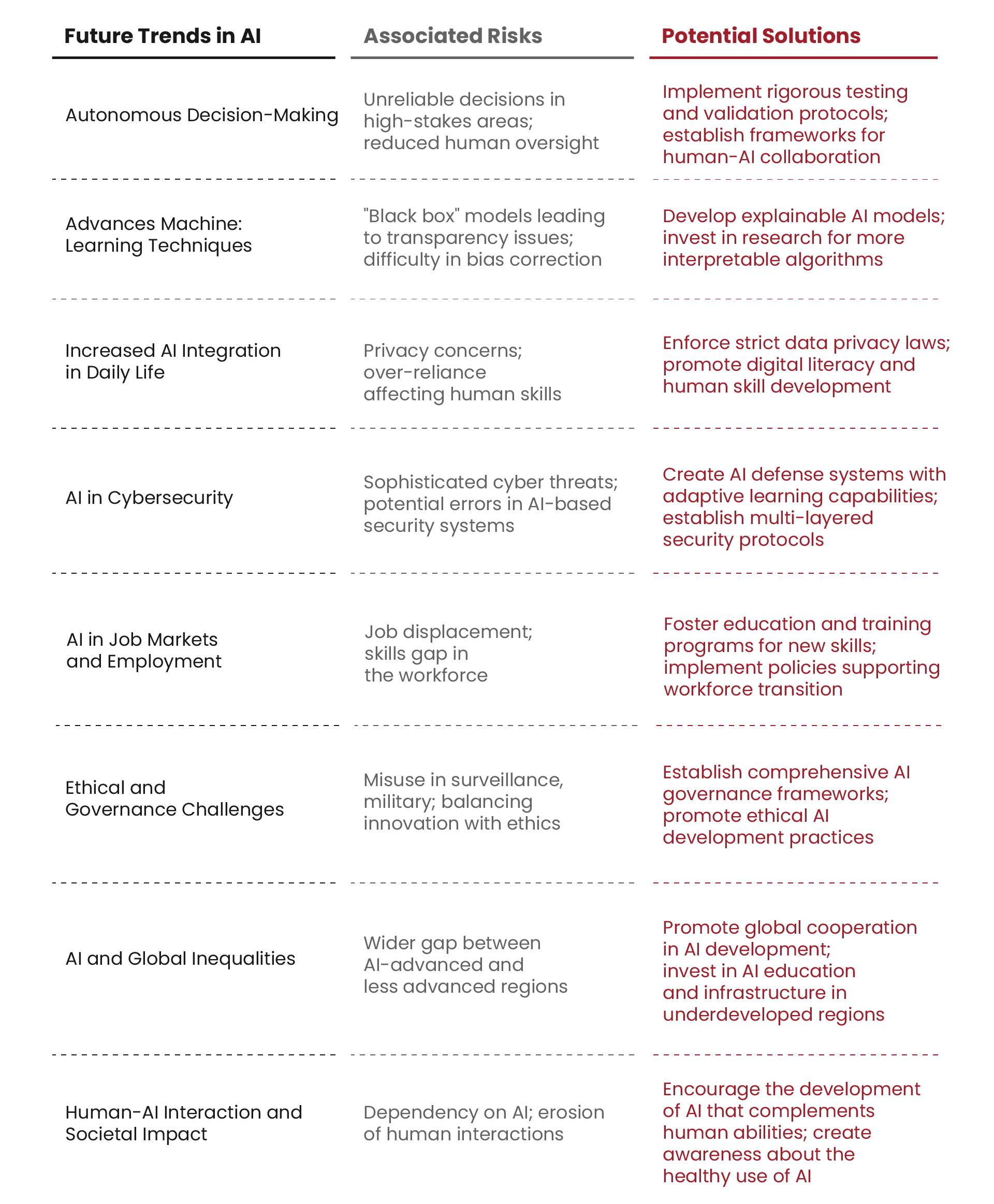The main purpose of Cybersecurity Awareness training course is to minimize huma....
Beyond the Code: Managing AI Risks in an Evolving Digital World

Artificial Intelligence (AI) is changing our lives in many ways, from healthcare to education, entertainment, and transportation. AI offers potential benefits like improved productivity, efficiency, and innovation. However, it also brings risks like ethical dilemmas, social impacts, and security threats. Hence, how can we ensure that AI is created and used responsibly and reliably, and how can we minimize the potential dangers?
In this article, we will explore some of the key issues that arise from the use of AI. We will also provide some suggestions and recommendations on how to manage AI risks to foster a culture of accountability and transparency in the AI ecosystem.
Understanding AI Risks
AI risks refer to the potential negative outcomes associated with the development, deployment, and use of AI technologies. These risks can manifest in various forms, from technical failures to ethical dilemmas, and can have significant consequences for individuals, organizations, and society as a whole. These risks include:
- Bias and discrimination - AI systems may have biases in their training data, which can lead to unfair outcomes. For instance, facial recognition software is less accurate for women and people of color, bringing up worries about fairness and equality. AI systems can sometimes generate false positives, leading to errors in their predictions and decisions.
- Privacy concerns - AI can invade privacy by analyzing large amounts of data. If AI algorithms analyze personal data without consent or in an intrusive manner, it can raise alarms about privacy and individual rights.
- Security threats - AI systems can be at risk of cyber-attacks and other security threats. The incorporation of AI into vital infrastructure, including power grids or financial systems, intensifies the possible consequences of such security breaches.
- Unemployment and job displacement - AI's automation capabilities may cause major changes to the job market, making certain jobs out of demand and raising concerns about employment and economic stability.
- Unintended consequences and misuse - AI can have unpredictable outcomes because of its complexity. The misuse of AI in surveillance, weaponry, or misinformation campaigns raises important ethical and security issues.
What Is AI Risk Management?
AI risk management refers to the systematic approach of identifying, assessing, and mitigating the potential risks associated with AI systems. As AI technologies become increasingly integrated into various aspects of society, there is a growing recognition of the need to proactively address these potential risks and challenges.
Strategies for creating an effective AI risk management include:
- Developing ethical AI guidelines - Establishing ethical guidelines for the development and use of AI, which encompasses ensuring fairness, transparency, privacy, and accountability.
- Implementing rigorous data governance - Ensuring data accuracy, quality, and integrity is crucial for AI systems, which rely heavily on data. Robust data governance protocols must be put in place to prevent biases and safeguard privacy.
- Conducting regular audits and assessments - This involves regular audits to assess their performance, identify potential biases or errors, and ensure compliance with ethical standards and regulations.
- Enhancing transparency of AI systems - The transparency of AI decision-making processes helps in building trust and facilitates accountability. This can be achieved through explainable AI (XAI) approaches, which make AI workings more understandable to users and stakeholders.
- Engaging a broad spectrum of stakeholders - Involving ethicists, industry experts, end-users, and policymakers in the AI development process ensures diverse perspectives are considered, leading to more ethically sound and socially responsible AI systems.
Ethical Dimensions of AI
The development of AI requires a strong focus on ethical considerations to ensure responsible and equitable innovation. Key areas include mitigating bias for fairness, maintaining transparency and accountability for user trust, and enforcing robust privacy protections. AI decisions must be understandable to users and respect their autonomy. In addition, AI should address socio-economic challenges such as job displacement and ensure safety from risks, advocating for a balance between automation and human oversight.
Ethical AI development also requires global collaboration on shared standards and governance to ensure that its benefits are globally inclusive and universally ethical. Prioritizing ethics ensures technology aligns with societal values for a positive impact on our shared future.
AI Governance and Regulatory Compliance
AI governance frameworks are sets of principles, guidelines, standards, best practices, and mechanisms that aim to steer the design, development, deployment, and use of AI systems towards desirable outcomes and away from harmful ones. They can be developed and applied at different levels, such as global, regional, national, or sectoral, and by different actors, such as public authorities, private entities, or multi-stakeholder initiatives.
Some examples of existing AI governance frameworks are:
-
The OECD Principles on Artificial Intelligence - These are five principles that were adopted by the Organisation for Economic Co-operation and Development (OECD) in 2019 and endorsed by 42 countries. They provide a common framework for promoting trustworthy AI that respects human rights and democratic values. The principles are:
- Inclusive growth, sustainable
- Human-centered value and fairness
- Transparency and explainability
- Robustness, security, and safety
- Accountability
-
The EU Ethics Guidelines for Trustworthy AI - These are seven requirements that were developed by the High-Level Expert Group on Artificial Intelligence (AI HLEG), an independent advisory body appointed by the European Commission. They provide a framework for achieving trustworthy AI that is ethical, lawful, and robust. The requirements are:
- Human agency and oversight
- Technical robustness and safety
- Privacy and data governance
- Transparency
- Diversity, non-discrimination, and fairness
- Societal and environmental well-being
- Accountability
-
The IEEE Ethically Aligned Design - These are eight general principles that were proposed by the IEEE Global Initiative on Ethics of Autonomous and Intelligent Systems, a global community of experts from various disciplines. They provide a vision for aligning the design of AI systems with ethical values. The principles are:
- Human rights
- Well-being
- Accountability
- Transparency
- Awareness of misuse
-
The Partnership on AI - This is a multi-stakeholder initiative that was founded by leading technology companies and civil society organizations in 2016. It aims to develop and share best practices for ensuring that AI is beneficial for humanity. It has six thematic pillars:
- Safety-critical AI
- Fairness, transparency, and accountability
- Collaboration between people and AI systems
- Social and societal influences of AI
- AI, labor, and the economy
- AI and social good.
Data Security in AI Systems
Ensuring robust data security in AI-driven projects requires a strategic approach. Here are key best practices:
- Encryption - Employ end-to-end encryption to protect data during storage, transmission, and processing.
- Access controls - Enforce strict access controls and robust authentication mechanisms to limit data access to authorized personnel.
- Secure storage - Store data securely using encrypted databases and cloud solutions, with regular audits to address vulnerabilities.
- Data minimization and retention - Follow data minimization principles and establish clear retention policies to reduce the impact of potential breaches.
- Audits and monitoring - Conduct regular security audits and implement continuous monitoring to detect and address anomalies promptly.
- Training - Educate personnel on data security best practices to mitigate risks associated with human error.
- Vendor assessment - Assess third-party vendors for security adherence when using external AI services or tools.
- Privacy by design - Embed privacy considerations into AI system design, proactively addressing security concerns.
- Incident response - Develop an incident response plan to swiftly and effectively address data breaches.
- Regulatory compliance - Stay compliant with data protection regulations to ensure ethical and responsible AI development.
Future Trends in AI and Associated Risks

What Is ISO/IEC 42001?
ISO/IEC 42001 is an under development standard that aims to provide a framework for the responsible and ethical use of artificial intelligence (AI) systems. It is expected to be published by the end of 2023 by the International Organization for Standardization (ISO) and the International Electrotechnical Commission (IEC).
ISO/IEC 42001 will specify the requirements and give guidance on establishing, implementing, maintaining, and continually improving an AI management system. This system will help organizations develop or use AI systems that meet their objectives, as well as the regulatory requirements, obligations, and expectations of interested parties.
The ISO/IEC 42001 Training Course by PECB is currently under development and is scheduled for launch in the first quarter of 2024. This course holds promise as a comprehensive program designed to provide participants with a deep understanding of the ISO/IEC 42001 standard, which focuses on systems and software engineering. As part of PECB's commitment to delivering high-quality training, the course is expected to cover key principles, requirements, and best practices outlined in the ISO/IEC 42001 standard.
Conclusion
In summary, going beyond the code is crucial for effective AI risk management, encompassing ethical considerations and societal impact. The call to action is clear: continuous learning and adaptation in AI risk management are essential. As the AI landscape evolves, staying informed about emerging risks, regulatory changes, and best practices is imperative.
Embracing a culture of ongoing education positions us to responsibly shape the future of AI, aligning with ethical principles and societal values. It is through continuous learning and adaptability that we can foster a resilient and ethically sound AI ecosystem.
About the Author
Vlerë Hyseni is the Digital Content Specialist at PECB. She is in charge of doing research, creating, and developing digital content for a variety of industries. If you have any questions, please do not hesitate to contact her at: content@pecb.com.


